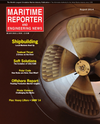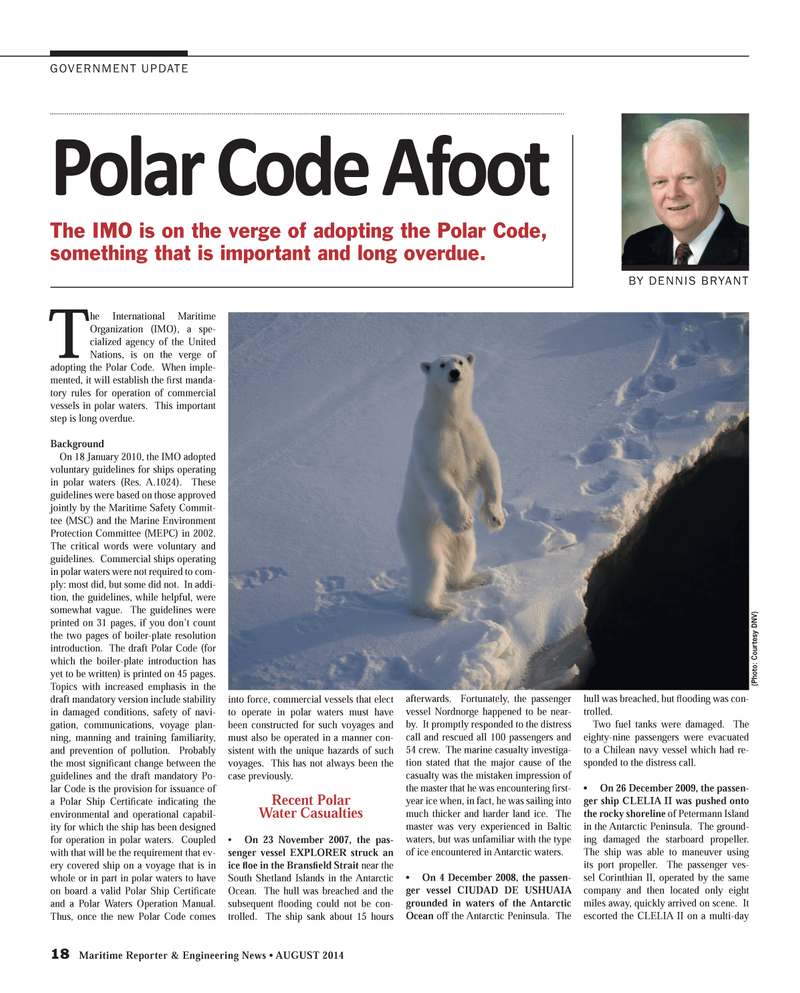
Page 18: of Maritime Reporter Magazine (August 2014)
Shipyard Edition
Read this page in Pdf, Flash or Html5 edition of August 2014 Maritime Reporter Magazine
18 Maritime Reporter & Engineering News ? AUGUST 2014 GOVERNMENT UPDATE The International Maritime Organization (IMO), a spe- cialized agency of the United Nations, is on the verge of adopting the Polar Code. When imple- mented, it will establish the Þ rst manda- tory rules for operation of commercial vessels in polar waters. This important step is long overdue.Background On 18 January 2010, the IMO adopted voluntary guidelines for ships operating in polar waters (Res. A.1024). These guidelines were based on those approved jointly by the Maritime Safety Commit-tee (MSC) and the Marine Environment Protection Committee (MEPC) in 2002. The critical words were voluntary and guidelines. Commercial ships operating in polar waters were not required to com-ply: most did, but some did not. In addi-tion, the guidelines, while helpful, were somewhat vague. The guidelines were printed on 31 pages, if you don?t count the two pages of boiler-plate resolution introduction. The draft Polar Code (for which the boiler-plate introduction has yet to be written) is printed on 45 pages. Topics with increased emphasis in the draft mandatory version include stability in damaged conditions, safety of navi-gation, communications, voyage plan-ning, manning and training familiarity, and prevention of pollution. Probably the most signiÞ cant change between the guidelines and the draft mandatory Po-lar Code is the provision for issuance of a Polar Ship CertiÞ cate indicating the environmental and operational capabil-ity for which the ship has been designed for operation in polar waters. Coupled with that will be the requirement that ev-ery covered ship on a voyage that is in whole or in part in polar waters to have on board a valid Polar Ship CertiÞ cate and a Polar Waters Operation Manual. Thus, once the new Polar Code comes into force, commercial vessels that elect to operate in polar waters must have been constructed for such voyages and must also be operated in a manner con-sistent with the unique hazards of such voyages. This has not always been the case previously. Recent Polar Water Casualties ? On 23 November 2007, the pas- senger vessel EXPLORER struck an ice ß oe in the Brans Þ eld Strait near the South Shetland Islands in the Antarctic Ocean. The hull was breached and the subsequent ß ooding could not be con- trolled. The ship sank about 15 hours afterwards. Fortunately, the passenger vessel Nordnorge happened to be near- by. It promptly responded to the distress call and rescued all 100 passengers and 54 crew. The marine casualty investiga- tion stated that the major cause of the casualty was the mistaken impression of the master that he was encountering Þ rst-year ice when, in fact, he was sailing into much thicker and harder land ice. The master was very experienced in Baltic waters, but was unfamiliar with the type of ice encountered in Antarctic waters. ? On 4 December 2008, the passen- ger vessel CIUDAD DE USHUAIA grounded in waters of the Antarctic Ocean off the Antarctic Peninsula. The hull was breached, but ß ooding was con- trolled. Two fuel tanks were damaged. The eighty-nine passengers were evacuated to a Chilean navy vessel which had re-sponded to the distress call.? On 26 December 2009, the passen- ger ship CLELIA II was pushed onto the rocky shoreline of Petermann Island in the Antarctic Peninsula. The ground- ing damaged the starboard propeller. The ship was able to maneuver using its port propeller. The passenger ves- sel Corinthian II, operated by the same company and then located only eight miles away, quickly arrived on scene. It escorted the CLELIA II on a multi-day Polar Code Afoot The IMO is on the verge of adopting the Polar Code, something that is important and long overdue. BY DENNIS BRYANT (Photo: Courtesy DNV) MR #8 (18-25).indd 18MR #8 (18-25).indd 188/1/2014 11:14:53 AM8/1/2014 11:14:53 AM

 17
17

 19
19
